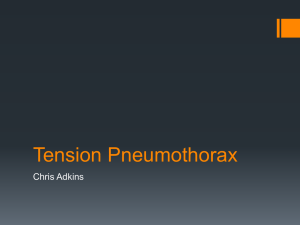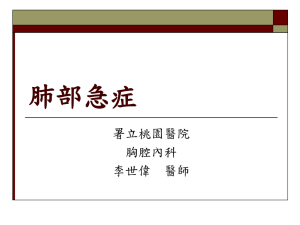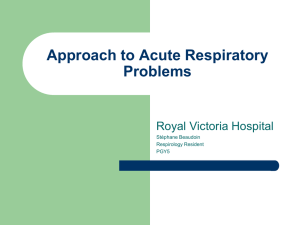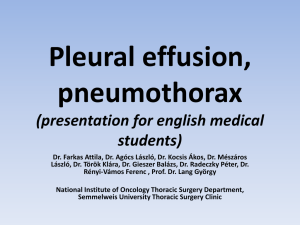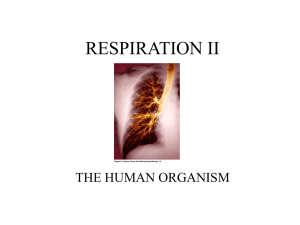from tragedy to traquiliy - The Cystic Fibrosis Center at Stanford
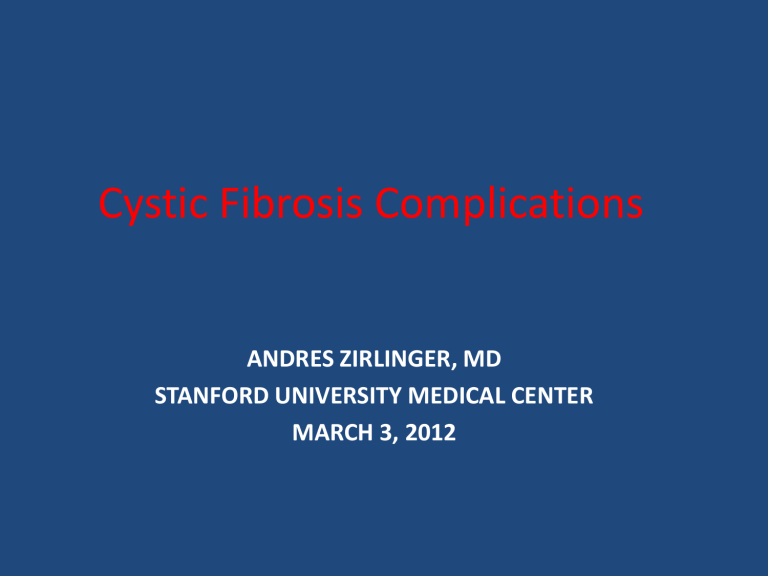
Cystic Fibrosis Complications
ANDRES ZIRLINGER, MD
STANFORD UNIVERSITY MEDICAL CENTER
MARCH 3, 2012
INTRODUCTION
PNEUMOTHORAX
HEMOPTYSIS
RESPIRATORY FAILURE
Cystic Fibrosis
Autosomal Recessive
Genetically transmitted disorder affecting
30,000 individuals in US and 60,000 worldwide
US incidence:1 per 1900-3700 Caucasians
Previously a pediatric disease
1990: 30% patients in US CFF Registry older than 18yrs
2012: More than 45% older than 18yrs.
Assuming improving care and therapies, the projected median survival is approximately 50 years of age for those born after 2000.
INTRODUCTION
PNEUMOTHORAX
HEMOPTYSIS
RESPIRATORY FAILURE
What is a pneumothorax (PTx)?
1803: First description in patients with pulmonary tuberculosis
Accumulation of air in the pleural space defined as the space between the lungs and chest wall
Primary Pneumothorax:
Spontaneous occurrence in patients with normal lungs
Secondary Pneumothorax:
Spontaneous occurrence in patients with abnormal lungs i.e Emphysema, Cystic Fibrosis
Normal lungs
Chest wall
Pleural space
Pneumothorax www.nlm.nih.gov, 2007
•
Normal CXR
PTx Collapsed
Lung tissue
Shift of heart
PTx
What causes a Pneumothorax?
May be related to chronic inflammation of the airways
Destruction and rupture of small lung units allowing air to leave the lung into the pleural space
Signs and symptoms
Asymptomatic (incidental finding on routine CXR or CT)
Various degrees of shortness of breath
Chest pain or pressure
Normal to decreased oxygen saturation
Increased heart rate
Low blood pressure
Respiratory failure
Cardiac arrest
Pneumothorax
Commonly reported in CF – 1 in 167 patients each year
CFF registry 1990-1999
3.4% of total population experienced at least one pneumothorax
82% with one event
18% with greater than one event
72.4% patients with first PTx are > 18 old
Average age of 1 st PTx 21.9
+/-
9.1 yrs
Average age of PTx did not change over the years
Flume et al, Chest 2005
Risk Factors for PTx
Pseudomonas aeruginosa
Burkholderia cepacia
Aspergillus / ABPA
FEV
1
≤ 30% predicted
Pancreatic insufficiency
Tube feeds
Medicaid
Treatment of Pneumothorax
Asymptomatic: PTx < 2 cm
Admit, observation, repeat CXR(S)
Mildly symptomatic: PTx < 2 cm and <50y
Needle aspiration
Symptomatic: PTx > 2 cm, and >50y
Persistent Pneumothorax
Consultation with thoracic surgeon
Caution in thoracic surgical procedures as they may make lung transplantation surgery complicated
Prognosis
Mortality after pneumothorax
48.6% at 2 years
75% at 8 years
***
Higher mortality associated with lower FEV
1
*** ?? Early referral for Lung Transplantation despite
FEV1 ≥ 30% predicted
INTRODUCTION
PNEUMOTHORAX
HEMOPTYSIS
RESPIRATORY FAILURE
What is hemoptysis?
Expectoration of blood from the respiratory tract
Massive Hemoptysis:
Coughing greater than 250ml of blood over 24 hours or recurrent bleeding with >100 ml/ day over several days
• Non-Massive Hemoptysis:
– Any quantity of blood less than mentioned above
Most common cause of Hemoptysis in CF patients
Chronic airway inflammation affects adjacent arterial supply
Tortuous vessels
Hypervascularity
Weakened vessel walls
Signs and symptoms
Expectoration of blood
Increasing shortness of breath
Increasing heart rate
Massive blood loss leading to low blood pressure
Respiratory failure
Cardiac arrest
Hemoptysis
4.1% of CF patients experience at least one episode of massive hemoptysis
74% will only have one episode
26% with greater than one episode
Majority (75%) of patients with first episode occurring after age 18
Risk factors for Massive hemoptysis
FEV1 < 30% predicted
Pseudomonas aeruginosa
Staphylococcus aureus
Burkholderia cepacia
Tube feeds
Cirrhosis
***lower risk observed in those patients receiving TOBI and pulmozyme
Treatment of hemoptysis
Bronchoscopy:
Attempts to visualize the region of bleeding
Not very effective as view might be obscured by blood
Bronchial artery embolization (BAE)
First reported embolization 1973
Recommended procedure of choice in massive hemoptysis
Studies demonstrating efficacy in nonmajor hemoptysis
Controls hemoptysis in approximately
90%
10-52% may require repeat BAE
BAE
Catheter inserted into groin, femoral artery
Contrast dye is injected into the arterial system
Polyvinyl alcohol particles are injected into potential bleeding sited to occlude the blood supply
Coils also used to occlude the bronchial arterial supply
BAE
Adverse effects
Chest pain
Difficulty swallowing
Bronchial necrosis/damage
Paraplegia: injury to spinal artery
Respiratory failure
Recent evidence suggests that this may relate to low FEV1 and lung irritation from bleeding and not from procedure
Prognosis after massive hemoptysis
Reported 44% mortality within one year
Mean age of hemoptysis 26.4 +/- 9 years
***majority of these patients with FEV<
30% predicted
INTRODUCTION
PNEUMOTHORAX
HEMOPTYSIS
RESPIRATORY FAILURE
Respiratory Failure
• Inadequate gas exchange
– Low oxygen levels (hypoxemic resp. failure)
– High carbon monoxide (hypercarbic resp. failure)
• Signs and Symptoms
– rapid respiratory rate
– breathlessness
– tachycardia
– low oxygen levels
– confusion
– loss of consciousness
– respiratory arrest
Respiratory Failure
Most common causes:
1) Pulmonary infectious exacerbation
2) Massive hemoptysis
3) Pneumothorax
4) other
Respiratory Failure
Previously most adult admissions to the ICU with high mortality
Better survival attributed to:
Better antibiotics
Faster response time to critically ill inpatients
Use of non-invasive ventilation
Non-invasive ventilation (NIV)
May decrease need for mechanical ventilation
Improves survival
Bridge to lung transplantation
For use in mild to moderate respiratory distress
Treatment
• Oxygen
• Mechanical ventilation (intubation or non invasive)
• Bronchodilators
• Antibiotics
• Treatment of precipitant (Pneumothorax, hemoptysis, etc.)
• Supportive care: nutrition, prevention of complications
Respiratory failure and ICU mechanical ventilation
Very high mortality
Associated with low FEV1
Discussion regarding end-of-life should be initiated
Eligible patients may have improved survival with lung transplantation
Summary
Cystic fibrosis with improved survival
Better strategies in treating critically ill patients
Pneumothorax and Massive hemoptysis with better outcomes if treated early; recurrence is not uncommon
Non-invasive ventilation improves survival, particularly if FEV1 > 30%.
Respiratory distress requiring mechanical ventilation has a high mortality
Aknowledgements
• Dr. Paul Mohabir


